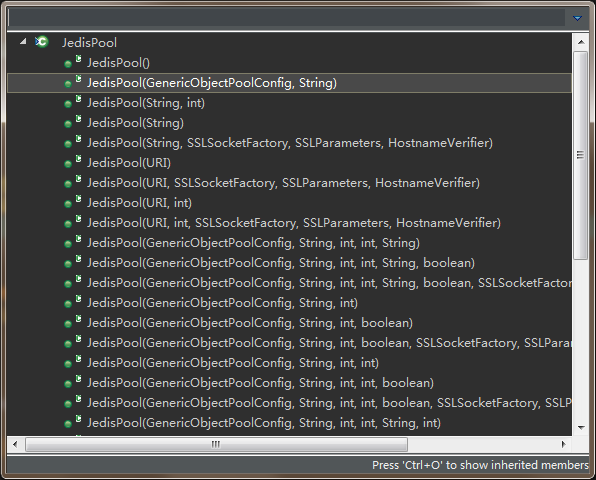springboot自动配置的redis并不是特别好用,所以需要我们使用原生的jedis,
1、添加依赖
2、在application文件中配置
# Redis服务器地址 redis.host= # Redis服务器连接端口 redis.port=6379 # 连接超时时间(毫秒) redis.timeout=3000 # Redis服务器连接密码(默认为空) redis.password=123456 # 连接池最大连接数(使用负值表示没有限制) redis.poolMaxTotal=10 # 连接池中的最大空闲连接 redis.poolMaxldle=10 # 连接池中的最小空闲连接 #redis.poolMinldle=10 # 连接池最大阻塞等待时间(使用负值表示没有限制) redis.poolMaxWait=-1
3、新建redis包,新建redisConfig类
本类的作用:加载application中的配置信息
@Component @ConfigurationProperties(prefix="redis") public class RedisConfig { private String host; private int port; private int timeout;//秒 private String password; private int poolMaxTotal; private int poolMaxIdle; private int poolMaxWait;//秒 public String getHost() { return host; } public void setHost(String host) { this.host = host; } public int getPort() { return port; } public void setPort(int port) { this.port = port; } public int getTimeout() { return timeout; } public void setTimeout(int timeout) { this.timeout = timeout; } public String getPassword() { return password; } public void setPassword(String password) { this.password = password; } public int getPoolMaxTotal() { return poolMaxTotal; } public void setPoolMaxTotal(int poolMaxTotal) { this.poolMaxTotal = poolMaxTotal; } public int getPoolMaxIdle() { return poolMaxIdle; } public void setPoolMaxIdle(int poolMaxIdle) { this.poolMaxIdle = poolMaxIdle; } public int getPoolMaxWait() { return poolMaxWait; } public void setPoolMaxWait(int poolMaxWait) { this.poolMaxWait = poolMaxWait; } }
@ConfigurationProperties(prefix="redis")的作用:
系统启动时,通过该注解将配置文件中以redis开头的配置加载到bean对象中来。
4、新建redisPoolFactory.
@Service public class RedisPoolFactory { @Autowired RedisConfig redisConfig; @Bean public JedisPool JedisPoolFactory() { JedisPoolConfig poolConfig = new JedisPoolConfig(); poolConfig.setMaxIdle(redisConfig.getPoolMaxIdle()); poolConfig.setMaxTotal(redisConfig.getPoolMaxTotal()); poolConfig.setMaxWaitMillis(redisConfig.getPoolMaxWait() * 1000); //可以有多种构造方法,通过自定义的配置来选择 JedisPool jp = new JedisPool(poolConfig, redisConfig.getHost(), redisConfig.getPort(), redisConfig.getTimeout()*1000, redisConfig.getPassword(), 0); return jp; } }
进入到JedisPool类中可以发现,该类只存在构造方法,用户可以根据业务需要调用想要的构造方法完成自定义的配置。

5、新建前缀类
在我们学习使用redis时,经常给存放的键取名为key1、key2这类完全没有含义的名称。如果是多人开发很难保证你使用的键不会被其他的覆盖掉,所以有必要给所有的键根据业务模块加上前缀。
那为什么不直接加上前缀,而是麻烦的使用一个类来实现呢?1、方便管理,所有的前缀都在一个包中。2、添加过期时间的功能。可自定义各个模块各类型的键的过期时间。
为了看起来统一规范,我们使用接口->抽象类->实现类这样的通用模板来实现加前缀的功能。
前缀接口:
public interface KeyPrefix { public int expireSeconds(); public String getPrefix(); }
抽象类:
public abstract class BasePrefix implements KeyPrefix{ //过期时间 private int expireSeconds; //前缀 private String prefix; public BasePrefix(String prefix) {//0代表永不过期 this(0, prefix); } public BasePrefix( int expireSeconds, String prefix) { this.expireSeconds = expireSeconds; this.prefix = prefix; } public int expireSeconds() {//默认0代表永不过期 return expireSeconds; } public String getPrefix() { String className = getClass().getSimpleName(); return className+":" + prefix; } }
user实现类:
public class UserKey extends BasePrefix{ private UserKey(String prefix) { super(prefix); } public static UserKey getById = new UserKey("id"); public static UserKey getByName = new UserKey("name"); }
这里过期时间使用默认值0。
具体如何设置过期时间,下面会有应用。
6、新建redisService
@Service public class RedisService { @Autowired JedisPool jedisPool; /** * 获取当个对象 * */ public <T> T get(KeyPrefix prefix, String key, Class<T> clazz) { Jedis jedis = null; try { jedis = jedisPool.getResource(); //生成真正的key String realKey = prefix.getPrefix() + key; String str = jedis.get(realKey); //默认返回的是String类型,需要将其转成T类型 T t = stringToBean(str, clazz); return t; }finally { returnToPool(jedis); } } /** * 设置对象 * */ public <T> boolean set(KeyPrefix prefix, String key, T value) { Jedis jedis = null; try { jedis = jedisPool.getResource(); //redis需要的是String类型,所以这里需要转换成String String str = beanToString(value); if(str == null || str.length() <= 0) { return false; } //生成真正的key String realKey = prefix.getPrefix() + key; int seconds = prefix.expireSeconds(); //判断是否需要设置过期时间,0表示永久存储 if(seconds <= 0) { jedis.set(realKey, str); }else { jedis.setex(realKey, seconds, str); } return true; }finally { returnToPool(jedis); } } /** * 判断key是否存在 * */ public <T> boolean exists(KeyPrefix prefix, String key) { Jedis jedis = null; try { jedis = jedisPool.getResource(); //生成真正的key String realKey = prefix.getPrefix() + key; return jedis.exists(realKey); }finally { returnToPool(jedis); } } /** * 增加值 * */ public <T> Long incr(KeyPrefix prefix, String key) { Jedis jedis = null; try { jedis = jedisPool.getResource(); //生成真正的key String realKey = prefix.getPrefix() + key; return jedis.incr(realKey); }finally { returnToPool(jedis); } } /** * 减少值 * */ public <T> Long decr(KeyPrefix prefix, String key) { Jedis jedis = null; try { jedis = jedisPool.getResource(); //生成真正的key String realKey = prefix.getPrefix() + key; return jedis.decr(realKey); }finally { returnToPool(jedis); } } //简单演示,可根据具体需求优化 private <T> String beanToString(T value) { if(value == null) { return null; } Class<?> clazz = value.getClass(); if(clazz == int.class || clazz == Integer.class) { return ""+value; }else if(clazz == String.class) { return (String)value; }else if(clazz == long.class || clazz == Long.class) { return ""+value; }else { return JSON.toJSONString(value); } } //简单演示,可根据具体需求优化 @SuppressWarnings("unchecked") private <T> T stringToBean(String str, Class<T> clazz) { if(str == null || str.length() <= 0 || clazz == null) { return null; } if(clazz == int.class || clazz == Integer.class) { return (T)Integer.valueOf(str); }else if(clazz == String.class) { return (T)str; }else if(clazz == long.class || clazz == Long.class) { return (T)Long.valueOf(str); }else { return JSON.toJavaObject(JSON.parseObject(str), clazz); } } private void returnToPool(Jedis jedis) { if(jedis != null) { jedis.close(); } } }
7、使用redis
@ResponseBody @GetMapping("/redis/set") public Result<Boolean> redis1(){ User user=new User(); user.setId(11); user.setUser_name("lhb"); redisService.set(UserKey.getById, "1", user); return Result.success(true); } @ResponseBody @GetMapping("/redis/get") public Result<User> redis2(){ User user = redisService.get(UserKey.getById, "1",User.class); return Result.success(user); }


注意:要确保你的redis支持远程连接